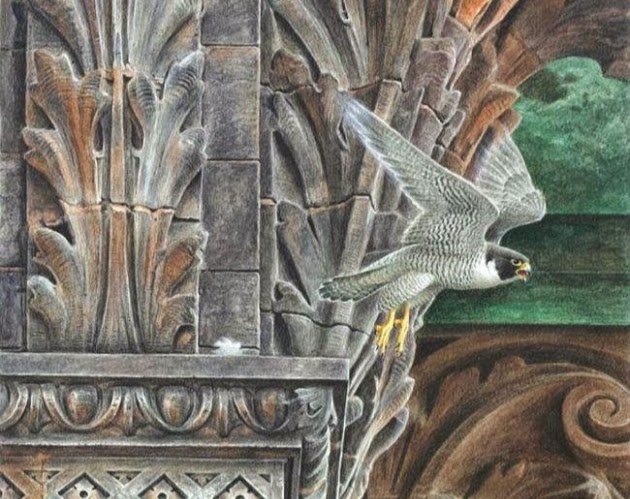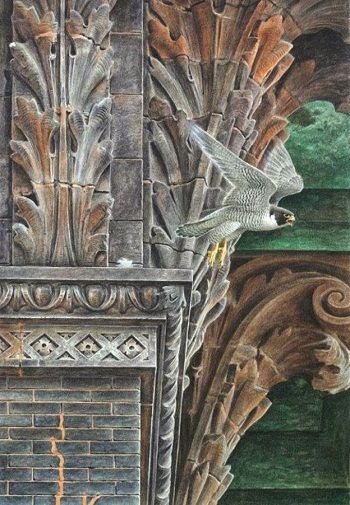
A Hooded Crow. Two Feral Pigeons. Three Feral Pigeons. One more Hooded Crow. And so on… not much of a birding day, heh? One more Feral Pigeon. I am inside the city of Belgrade, checking the theoretically possible Peregrine Falcon site. Not that anyone has seen it there, but if I were a Peregrine, that would be one of the properties I would seriously consider. One Feral Pigeon. A Great Tit. Yet, not a trace of a falcon.
Some lovely and touristy cities of Western Europe are justly proud of their cathedral Peregrines (Barcelona, Norwich, Bristol), even London (which has its charms, but is far from lovely) – why not Belgrade (isn’t proud, I mean)?
 Painting (c) by Paschalis Dougalis.
Painting (c) by Paschalis Dougalis.
Serbia has a large number of pigeon fanciers and a long history of lack of law enforcement in the field of wildlife crime (Newsweek on poaching in the Balkans). This excerpt comes from a blog of one such Serbian pigeon fancier (the entries had to be translated first): “11 April: first kamikazes flew off and clearly brought a hawk to the ground. APRIL 12: Second flight of a bitch and then she hunts. Tomorrow kamikaze and war to extinction.” Falcons do hunt pigeons, we all know that, but what is a Kamikaze pigeon? And a war to extinction??
The weakest bird from a pigeon fancier aviary gets a dubious honour to be promoted into a Kamikaze. Instead of a ceremonial cup of sake, it gets smeared with a nerve poison. The falcon, obviously, goes after the slowest pigeon, takes it in mid-air and brings it to its nest, where it starts plucking it up for its chicks and quickly succumbs to the poison, as shown in this Peregrine nest camera footage: https://www.youtube.com/watch?v=8kKoL3sdbaQ
This time it is not in Serbia, but in Zurich, Switzerland, where this particular Serbian pigeon fancier / blogger lives. There were several incidents involving poisoned Peregrines in that area, so the police and the SVS / BirdLife Switzerland started to investigate the case, assisted by the group of conservationists from Serbia (the news in German). Extensive investigations by the police apparently led to a strong suspicion, but there have been no convictions to date.
Back to Serbia, three large pigeon-taking predators – Peregrine and Saker Falcons and the Northern Goshawk – have become increasingly hard to find in the last ten years. Take the Saker for example: with 52 to 64 breeding pairs ten years ago, Serbia held 13 per cent of the European population of this Globally Threatened species (source). According to the latest census done by the BPSSS / BirdLife Serbia, the population has now plummeted to a maximum of 21 pairs. And all we have are strong suspicions, but no hard evidence.
That is why Belgrade is not proud of its falcons and why I am not telling you more about them.













My goodness, that is sick. Thanks for reporting it, I hope they put him in jail ASAP. Or, that someone releases all of his pigeons before he can turn any more into kamikazes.
The problem is, he is not a solitary case, but a symptom of a more widespread disease.
Beside Serbia, in the last few years similar Peregrine poisonings were recorded in Austria and Germany, too.
Not all pigeon flyers want to kill birds of prey i am both a pigeon flyer and a naturelist and love to see peregrines hunt its survival of the fittest and entirely natureal
I know, that is why I deleted one sentence from the first draft.
But we do have a huge problem in Serbia and it is spilling overseas into Central Europe (Austria, Germany, Switzerland). We find not only dead, but mutilated birds: blinded falcons or with their claws cut off and then released only to die of starvation, or smeared with petrol, set ablaze and released like a flying torch. It’s not just sick – it’s clinically sick. And illegal, too.
But the legal issues attract no attention and conservationists have no evidence of the names of the criminals who did it. One recent case I heard of (without any names) was a pigeon fancier in Belgrade hiring a professional sniper to take down a Peregrine.